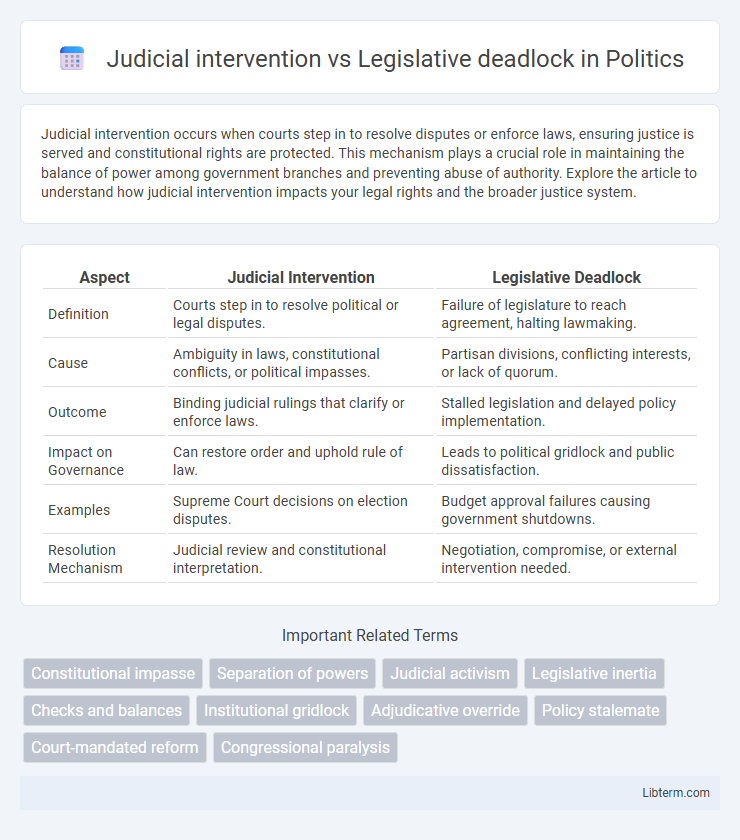Judicial intervention occurs when courts step in to resolve disputes or enforce laws, ensuring justice is served and constitutional rights are protected. This mechanism plays a crucial role in maintaining the balance of power among government branches and preventing abuse of authority. Explore the article to understand how judicial intervention impacts your legal rights and the broader justice system.
Table of Comparison
| Aspect | Judicial Intervention | Legislative Deadlock |
|---|---|---|
| Definition | Courts step in to resolve political or legal disputes. | Failure of legislature to reach agreement, halting lawmaking. |
| Cause | Ambiguity in laws, constitutional conflicts, or political impasses. | Partisan divisions, conflicting interests, or lack of quorum. |
| Outcome | Binding judicial rulings that clarify or enforce laws. | Stalled legislation and delayed policy implementation. |
| Impact on Governance | Can restore order and uphold rule of law. | Leads to political gridlock and public dissatisfaction. |
| Examples | Supreme Court decisions on election disputes. | Budget approval failures causing government shutdowns. |
| Resolution Mechanism | Judicial review and constitutional interpretation. | Negotiation, compromise, or external intervention needed. |
Introduction: Defining Judicial Intervention and Legislative Deadlock
Judicial intervention occurs when courts step in to resolve disputes or interpret laws due to legislative inaction or ambiguity, ensuring enforcement of constitutional principles. Legislative deadlock arises when elected bodies fail to pass necessary laws because of political gridlock or partisan disagreements, impeding effective governance. The dynamic between judicial intervention and legislative deadlock highlights the balance of power between judiciary oversight and legislative responsibility in democratic systems.
Historical Context of Judicial Involvement in Governance
Judicial intervention in governance historically emerged as a mechanism to resolve legislative deadlocks and uphold constitutional principles, particularly during periods of political stalemate or ineffective lawmaking. Landmark cases such as Marbury v. Madison established judicial review as a foundational tool for courts to interpret and enforce constitutional limits on legislative and executive actions. Over time, this judicial role evolved to balance powers, ensuring that legislative paralysis did not undermine the rule of law or citizens' rights.
Causes and Consequences of Legislative Deadlocks
Legislative deadlocks often arise from deep partisan divisions, conflicting policy priorities, or institutional gridlock within bicameral legislatures, impeding the passage of critical laws. These deadlocks cause governmental paralysis, delaying policy implementation and eroding public trust in democratic processes. Judicial intervention frequently occurs as courts resolve disputes over constitutional interpretation or enforce legislative compliance, thus temporarily bypassing legislative inaction but raising concerns about judicial overreach.
The Role of the Judiciary in Resolving Legislative Stalemates
The judiciary plays a crucial role in resolving legislative stalemates by interpreting constitutional provisions and ensuring that laws comply with fundamental rights and legal principles. Courts often step in to adjudicate disputes arising from legislative gridlock, providing binding decisions that clarify ambiguous statutes or invalidate unconstitutional provisions. This judicial intervention safeguards the balance of power, enabling governance to proceed when legislative bodies are deadlocked.
Notable Cases of Judicial Intervention Amidst Legislative Inaction
Notable cases of judicial intervention during legislative deadlock include the U.S. Supreme Court's landmark decision in Brown v. Board of Education, which addressed racial segregation in public schools when Congress failed to act. Similarly, the Indian Supreme Court's proactive stance in the Kesavananda Bharati case established basic structure doctrine amidst political stalemates. These instances highlight courts stepping in to uphold constitutional principles and protect citizen rights when legislatures remain stagnant.
Constitutional Limits on Judicial Power
Judicial intervention is constrained by constitutional limits that prevent courts from overstepping their interpretive role and encroaching on legislative functions, preserving the separation of powers. Courts typically avoid stepping into legislative deadlocks unless there is a clear constitutional violation, maintaining judicial restraint. These limits ensure that judicial power is exercised only within the boundaries set by the constitution, preventing the judiciary from substituting its judgment for that of the legislature.
The Impact of Judicial Intervention on Democratic Processes
Judicial intervention can resolve legislative deadlock by interpreting constitutional provisions and ensuring the enforcement of laws, thus maintaining the functionality of democratic institutions. Courts often act as arbiters when legislative bodies fail to reach consensus, protecting individual rights and upholding the rule of law during political stalemates. However, excessive judicial activism risks undermining democratic legitimacy by encroaching on the policymaking role of elected representatives.
Public Perception and Political Debate Surrounding Judicial Decisions
Judicial intervention often sparks intense public debate as citizens and political leaders evaluate the legitimacy of courts shaping policy amid legislative deadlock. Public perception varies widely, with some viewing judicial decisions as necessary checks on political stagnation, while others criticize courts for overstepping democratic boundaries. This tension fuels ongoing political discourse regarding the balance of power and the appropriate role of judicial authority in resolving policy impasses.
Comparative Analysis: International Approaches to Judicial vs Legislative Authority
Judicial intervention varies significantly across international legal systems, with countries like the United States embracing strong judicial review mechanisms, while others such as the United Kingdom limit courts' ability to override parliamentary decisions. Legislative deadlock often prompts judicial bodies in federal systems like Germany and Canada to interpret constitutional provisions to resolve conflicts, whereas in parliamentary systems legislative deadlocks typically prompt political negotiations rather than judicial rulings. Comparative analysis reveals that judicial authority functions as a crucial check in countries with codified constitutions, contrasting with systems where legislative sovereignty prevails, impacting the balance of power and governance efficacy globally.
Conclusion: Striking a Balance Between Judicial Action and Legislative Responsibility
Judicial intervention resolves legislative deadlock by ensuring constitutional compliance and protecting rights when lawmakers fail to act. Excessive judicial activism risks undermining democratic principles, while legislative paralysis disrupts effective governance and public trust. Striking a balance requires courts to respect legislative prerogatives while stepping in decisively when fundamental legal or constitutional issues remain unaddressed.
Judicial intervention Infographic

 libterm.com
libterm.com